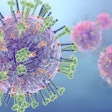
Researchers have developed a portable laboratory device for rapid onsite detection of SARS-CoV-2 RNA which holds promise for scenarios in which there is no or limited access to testing laboratories.
In the study, published in Microbiology Spectrum, researchers led by Kouichi Kitamura, PhD, of the National Institute of Infectious Diseases in Tokyo used two portable laboratory devices to develop a method for the onsite detection of SARS-CoV-2 RNA on surfaces.
The researchers sought to detect viruses present on frequently touched surfaces, such as doorknobs and tables. They conducted experiments using inactivated viral particles containing partial sequences not only of SARS-CoV-2 but also of type 1 poliovirus, coxsackie virus A16, and norovirus genogroups I and II as simulated contaminants applied to materials such as plastic and stainless steel -- i.e., “typical surfaces of high-contact objects such as tables, keyboards, toys, door handles, faucets, and sinks,” the authors noted.
After the contaminants had dried, the researchers collected the particles with swabs from the surfaces to develop their method of onsite detection using the PicoGene PCR1100 portable device. The research team also used the Bento Lab microcentrifuge extracting viral RNA; this method allowed for highly sensitive detection even for very small quantities of viruses.
Not only did their technique show high sensitivity in virus detection, but the 30-minute turnaround time for the PicoGene device was also faster than that of conventional testing.
“Identifying SARS-CoV-2 RNA on these surfaces can be crucial in guiding decision-making for implementing non-pharmaceutical interventions, such as zoning strategies, improving ventilation, maintaining physical distancing, and promoting increased hand hygiene practices,” the researchers wrote. “Moreover, the on-site detection system can facilitate the swift initiation of mitigation responses in non-laboratory settings, including long-term care facilities and schools.”
In addition, the research team notes that their onsite detection technique could be used for other viruses in similar circumstances, such as enteroviruses and noroviruses.



















